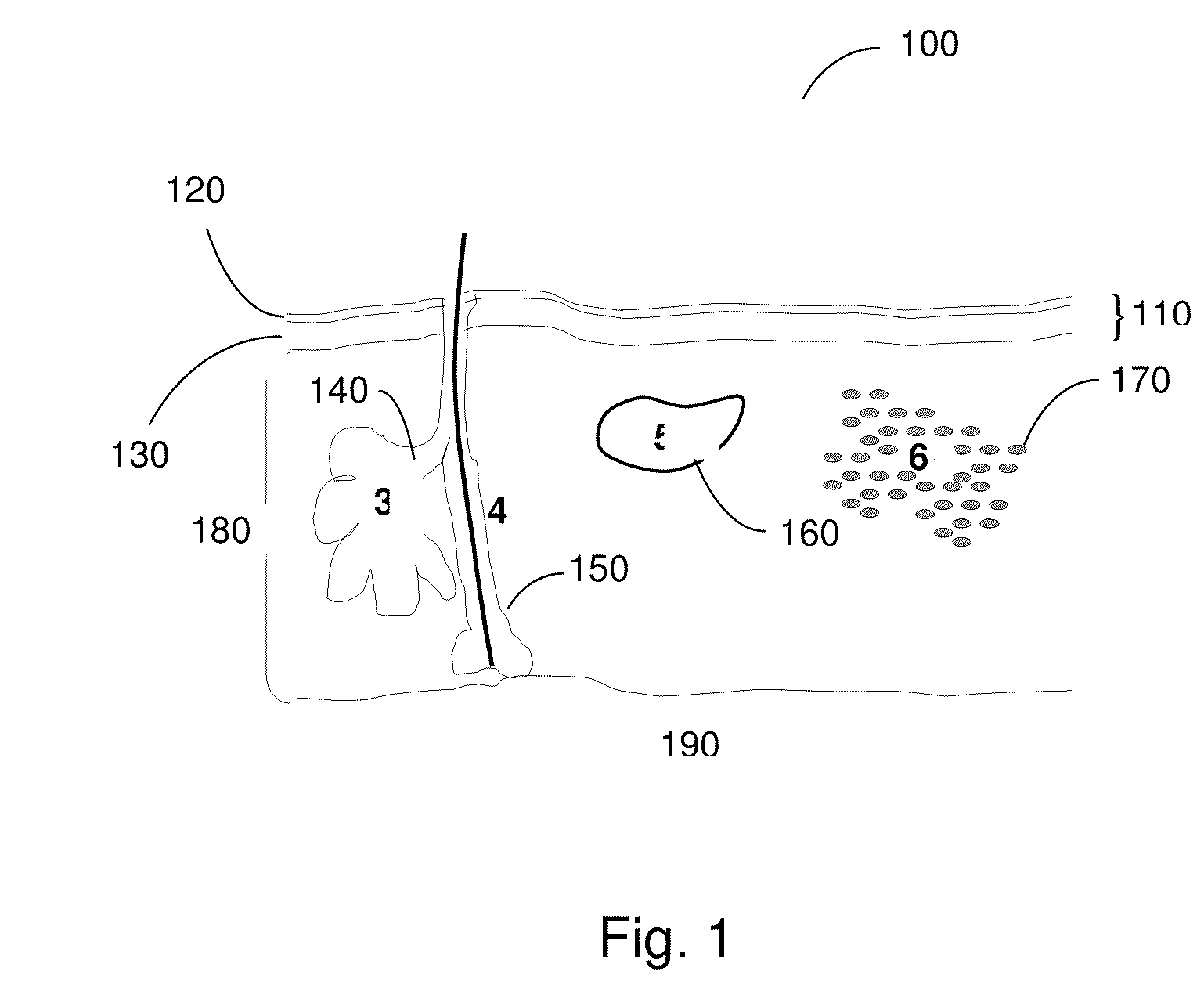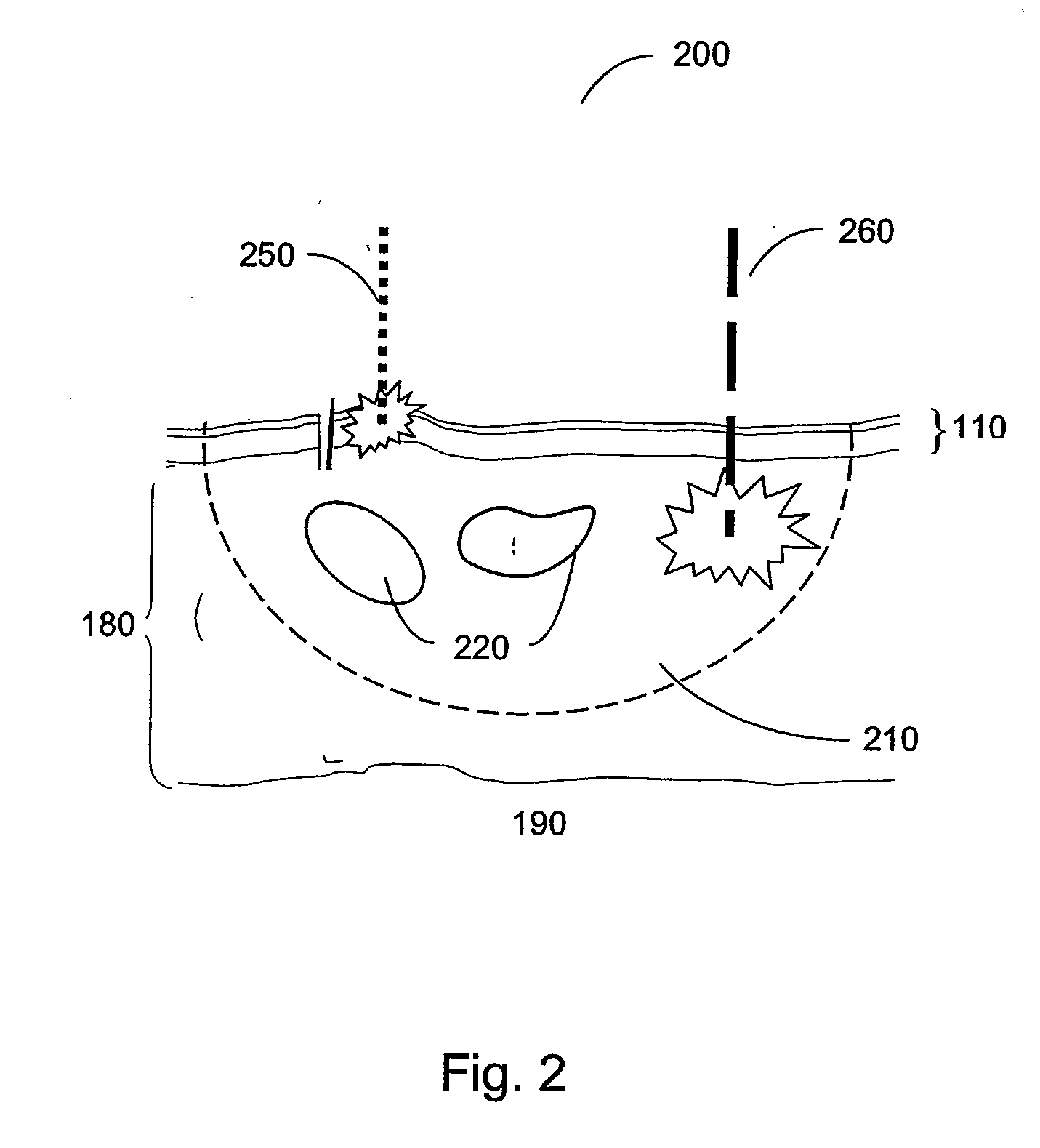Method and apparatus for optical inhibition of photodynamic therapy
a photodynamic therapy and optical inhibition technology, applied in the field of optical inhibition of photodynamic therapy, can solve the problems of non-selective accumulation of precursor photosensitizers and/or photosensitizers, unintended damage to non-targeted healthy surface tissue during subsequent pdt treatment, etc., and achieve the effect of preventing or reducing the extent or likelihood of unwanted damag
- Summary
- Abstract
- Description
- Claims
- Application Information
AI Technical Summary
Benefits of technology
Problems solved by technology
Method used
Image
Examples
example 1
[0120]Suppression of epidermal porphyrin accumulation by blue light exposure during ALA metabolism, in accordance with exemplary embodiments of the present invention, was tested in humans. With reference to FIG. 6, a 20% topical ALA solution was applied to human skin 610, covered with aluminum foil 620, while only some uncovered areas received 410-nm blue light (1.47 mW / cm2) 630 during the incubation time. A fluorescent photo 640 was taken after 2 hours of incubation, and 632-nm light (100 J / cm2) was then applied to all areas 650. A clinical photograph 660 was taken after PDT treatment.
[0121]Blue light exposure during the period of ALA metabolism was observed to suppressed porphyrin accumulation and subsequent PDT reactions. Inactivation of porphyrin synthetic enzymes or the pre-porphyrin metabolites, concurrent repair of oxidative damage during blue light exposure, and / or changes in cell signaling may contribute to this observed effect. Such findings indicate that exemplary embodim...
example 2
[0123]In accordance with embodiments of the present invention, 20% topical ALA was applied to the skin of a pig. Nine different areas were divided and different attenuating films were placed over the skin during the entire incubation time (or the metabolism period). The attenuating films reduced the light transmittance allowing a range of irradiance varying from 100%, 56%, 44%, 35%, 26%, 21%, 19% to 17% of light during the incubation period.
[0124]Immediately after the drug application, a 410 nm blue light was irradiated through all the experiment sites at an irradiance of 2.6 mW / cm2 for 3 hours. During this period, porphyrin accumulation was measured in each test area by digital fluorescence photography (˜410 nm excitation, >600 nm emission), and microscopically determined by fluorescence microscopy of skin biopsies (8 mm diameter) obtained prior to light exposure. After the 3 hours of incubation, red light at 635 nm exposure with 200 J / cm2 fluence was delivered at 100 mW / cm2 irradi...
example 3
[0126]Embodiments of the present invention were used to treat a 23 year old female Asian patient exhibiting moderate to severe inflammatory acne (acne III-IV). The patient's recalcitrant acne was resistant to conventional treatments (oral and topical antibiotics, topic retinoids and benzoyl peroxide), and failed to respond to Accutane treatment (2 cycles). A 20% ALA solution (Dusa Pharmaceutics) was applied topically to the patient's face. The right side of the patient's face was covered with saran wrap and aluminum foil for 3 hours of incubation (to provide a conventional PDT treatment), while blue light at very low intensity (an inhibiting radiation) was applied to the left side of the patient's face for 3 hours (using a Clearlight at 90 W / cm2, provided about 2 meters from the patient).
[0127]After the incubation period, both sides of the face were irradiated with red light treatment radiation (635 nm wavelength, at about 180 J / cm2, using an Aktilite). During the red light irradiat...
PUM
 Login to View More
Login to View More Abstract
Description
Claims
Application Information
 Login to View More
Login to View More - R&D
- Intellectual Property
- Life Sciences
- Materials
- Tech Scout
- Unparalleled Data Quality
- Higher Quality Content
- 60% Fewer Hallucinations
Browse by: Latest US Patents, China's latest patents, Technical Efficacy Thesaurus, Application Domain, Technology Topic, Popular Technical Reports.
© 2025 PatSnap. All rights reserved.Legal|Privacy policy|Modern Slavery Act Transparency Statement|Sitemap|About US| Contact US: help@patsnap.com



